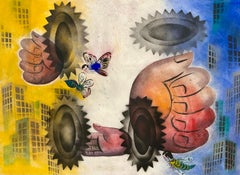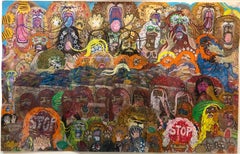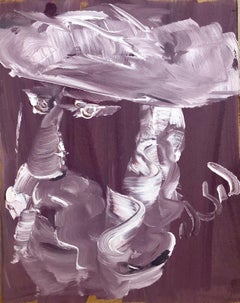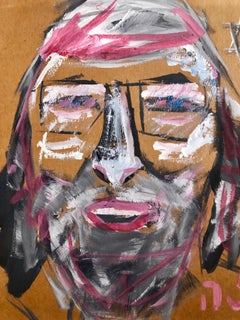Want more images or videos?
Request additional images or videos from the seller
1 of 9
Abraham LevinThe Jewish Family (untitled)
$2,200List Price
About the Item
- Creator:Abraham Levin (1880 - 1957, Lithuanian)
- Dimensions:Height: 11 in (27.94 cm)Width: 14 in (35.56 cm)
- Movement & Style:
- Period:
- Condition:
- Gallery Location:Surfside, FL
- Reference Number:1stDibs: LU382116540
About the Seller
4.9
Platinum Seller
Premium sellers with a 4.7+ rating and 24-hour response times
Established in 1995
1stDibs seller since 2014
1,810 sales on 1stDibs
Typical response time: 1 hour
Authenticity Guarantee
In the unlikely event there’s an issue with an item’s authenticity, contact us within 1 year for a full refund. DetailsMoney-Back Guarantee
If your item is not as described, is damaged in transit, or does not arrive, contact us within 7 days for a full refund. Details24-Hour Cancellation
You have a 24-hour grace period in which to reconsider your purchase, with no questions asked.Vetted Professional Sellers
Our world-class sellers must adhere to strict standards for service and quality, maintaining the integrity of our listings.Price-Match Guarantee
If you find that a seller listed the same item for a lower price elsewhere, we’ll match it.Trusted Global Delivery
Our best-in-class carrier network provides specialized shipping options worldwide, including custom delivery.You May Also Like
Mississippi River Landscape
By Saul Haymond
Located in Lake Worth Beach, FL
Landscape Mississippi River.
Saul Haymond, Sr. (1947- ) of Pickens, Mississippi is a self-taught painter who has been documenting life in the African American community in Holmes Co...
Category
1960s Outsider Art Landscape Paintings
Materials
Canvas, Oil
Napoleon at the Head of His Grande Armée, His Generals and the Prussian Hussars
Located in Cotignac, FR
Pencil, chalk and watercolour depiction of Napoleon at the head of his generals by French artist Jean Ducel. The work is signed bottom right.
A bold and graphic depiction of Napoleo...
Category
Late 20th Century Outsider Art Figurative Drawings and Watercolors
Materials
Chalk, Crayon, Cardboard, Pencil, Watercolor
JOLLY RIDER
Located in CÓRDOBA, ES
Acrylic on canvas.
Original art by Daria Kusto.
Shipped well protected,
rolled in a tube, unframed from Spain.
Category
2010s Outsider Art Animal Paintings
Materials
Acrylic
Mysticism Mohammad Ariyaei 21st Century painting outsider Iranian art colourful
By Mohammad Ariyaei
Located in Paris, FR
Acrylic paint on canvas
Hand-signed lower right
« Here the barbaric or savage ceremonies of New Guinea take on the air of Rio carnival.
Here the vitality bursts and the colors dance the jig while thundering.
A charivari of African masks, children's drawings and neon colors invades the meticulously meshed backdrops with volcanic overflows.
It seems that within a kindergarten class, merry feathered wizards have joined together to cover the canvas or the paper with totemic figures strewn with the most inventively unexpected graffiti, in a creative frenzy so bubbling that the anarchy that threat recovers as in spite of itself a semblance of balance.
The graphic design performs an enveloping and virtuoso dance that passes from the most wisely academic exercise to the most exuberant and Dionysian lyrical expressionism.
It's flamboyant, paroxysmal and wonderfully joyful.
Should we detect here any influence of the spirit of "outsider art", today widespread worldwide?
Perhaps, but then it is undeniable that the personal temperament of Mohammad ARIYAEI...
Category
2010s Outsider Art Figurative Paintings
Materials
Canvas, Acrylic
$11,439
H 64.97 in W 66.93 in D 1.97 in
Victory by abandonment Julien Wolf Contemporary art painting expressionnist
By Julien Wolf
Located in Paris, FR
Oil paint on canvas
Hand-signed on the back by the artist
“At first glance, we are invited to a colorful carnival. Everything is movement here! As if Julien Wolf had tried to captur...
Category
2010s Outsider Art Figurative Paintings
Materials
Canvas, Oil
$4,696
H 29.93 in W 22.05 in D 1.97 in
International feminism Mohammad Ariyaei 21st Century Iranian art outsider art
By Mohammad Ariyaei
Located in Paris, FR
Acrylic paint on paper
Signed by the artist
Category
2010s Outsider Art Figurative Paintings
Materials
Paper, Acrylic
$3,492
H 19.69 in W 27.56 in D 1.97 in
Simorgh Mohammad Ariyaei 21st Century Iranian painting outsider art mystic bird
By Mohammad Ariyaei
Located in Paris, FR
Acrylic paint on paper
Signed by the artist
Category
2010s Outsider Art Figurative Paintings
Materials
Paper, Acrylic
$3,010
H 27.56 in W 19.69 in
Jins' parallel world Mohammad Ariyaei 21st Century Iranian outsider art painting
By Mohammad Ariyaei
Located in Paris, FR
Acrylic paint on paper
Signed by the artist
Category
2010s Outsider Art Figurative Paintings
Materials
Paper, Acrylic
$3,492
H 27.56 in W 19.69 in D 1.97 in
Love poem Mohammad Ariyaei 21st Century Iranian art outsider art painting
By Mohammad Ariyaei
Located in Paris, FR
Acrylic paint on paper
Signed by the artist
Category
2010s Outsider Art Figurative Paintings
Materials
Paper, Acrylic
$4,696
H 39.38 in W 27.56 in D 1.97 in
Glory to the woman Mohammad Ariyaei 21st Century Iranian art outsider art paint
By Mohammad Ariyaei
Located in Paris, FR
Acrylic paint on paper
Signed by the artist
Category
2010s Outsider Art Figurative Paintings
Materials
Paper, Acrylic
$4,696
H 27.56 in W 39.38 in D 1.97 in
More From This Seller
View AllOutsider Art Abstract Surrealist Spray Paint Mixed Media Painting Mason Rader
Located in Surfside, FL
"Tin Can Hands" 1995 by Mason Rader
A graduate of the L. Jeffrey Selznick School of Film Preservation at the George Eastman House in Rochester NY with a B...
Category
1990s Outsider Art Abstract Paintings
Materials
Mixed Media, Spray Paint
The Mean Hippies (Drawing with Rattlesnake Warrior and Red Rebels) Outsider Art
By Alex O'Neal
Located in Surfside, FL
Paper measures 21 X 33 inches
Born and raised in Mississippi, Alex O'Neal graduated from Rhode Island School of Design and School of the Art Institute of Chicago. In the Eighties, his formal education overlapped regular visits with Mississippi self-taught artists, including Mary T. Smith, Luster Willis, and Son Ford Thomas. He later immersed himself in art brut collections and European art brut in Switzerland, Germany, and France. His work is also inspired by African-American self-taught outsider art. O'Neal's drawings and paintings have been shown at The Drawing Center, New York; BRIC, Brooklyn; P.S.122, New York; Johnson Museum of Art, Ithaca, NY; Woodruff Arts Center, Atlanta; Tennessee Arts Commission, Nashville; Mississippi Museum of Art, Jackson, MS; Centre d’Art des Pénitents Noirs, Aubagne, France; Contemporary Arts Center, New Orleans; Chicago Cultural Center; Ecomuseu, Valls d'Aneu, Spain; Amory Arts Center, West Palm Beach; Huntsville Museum of Art, AL; Rockefeller Art Center, SUNY Fredonia; ART LA; Field Projects, New York; LOG at Lump Gallery, Raleigh, NC; and Linda Warren Projects, Chicago. His work is in volumes 16, 38, and 104 of New American Paintings. His paintings and drawings idiosyncratically depict circumstances that associate Americans, i.e. dysfunction, nature worship, cults, homegrown terrorism, Hollywood, reverence for Native America. There is formal influence from stylization found in Romanesque fresco, early American portrait painting...
Category
21st Century and Contemporary Outsider Art Figurative Paintings
Materials
Oil Pastel, Archival Paper
Outsider Folk Art Expressionist Rabbi Israeli Painting Signed Hebrew Jewish Star
Located in Surfside, FL
This is a signed portrait painting done in an outsider, folk art, expressionist style. it is signed in Hebrew, also marked with a Jewish star. this is from a collection of works by the same hand. they are all signed. Some have markings to the back of the paper. they have some age to them. They bear similarities to artists as dissimilar as Moshe Tamir, Mane Katz and an Israeli version of Purvis Young. In this piece the artist choice of colors is muted yet powerful.
Israel has had a Vibrant Folk Art, Naive art scene for a long time now, artists like Yisrael Paldi, Nahum Guttman, Reuven Rubin and even Yefim...
Category
20th Century Outsider Art Portrait Paintings
Materials
Gouache
Outsider Folk Art Expressionist Rabbi Israeli Painting Signed Hebrew Jewish Star
Located in Surfside, FL
This is a signed portrait painting done in an outsider, folk art, expressionist style. This one looks like a Chassidic Breslov Hasidic man. it is signed in Hebrew, also marked with a Jewish star. this is from a collection of works by the same hand. they are all signed. Some have markings to the back of the paper. they have some age to them. They bear similarities to artists as dissimilar as Moshe Tamir, Mane Katz and an Israeli version of Purvis Young. In this piece the artist choice of colors is muted yet powerful.
Israel has had a Vibrant Folk Art, Naive art scene for a long time now, artists like Yisrael Paldi, Nahum Guttman, Reuven Rubin and even Yefim Ladyzhensky...
Category
20th Century Outsider Art Portrait Paintings
Materials
Gouache
Outsider Folk Art Expressionist Rabbi Israeli Painting Signed Hebrew Jewish Star
Located in Surfside, FL
This is a signed portrait painting done in an outsider, folk art, expressionist style. it is signed in Hebrew, also marked with a Jewish star. this is from a collection of works by the same hand. they are all signed. Some have markings to the back of the paper. they have some age to them. They bear similarities to artists as dissimilar as Moshe Tamir, Mane Katz and an Israeli version of Purvis Young. In this piece the artist choice of colors is muted yet powerful.
Israel has had a Vibrant Folk Art, Naive art scene for a long time now, artists like Yisrael Paldi, Nahum Guttman, Reuven Rubin and even Yefim Ladyzhensky had naive periods. The most well know of the strict naive artists are Shalom of Safed, Irene Awret, Gabriel Cohen, Natan Heber, Michael Falk and Kopel Gurwin.
Naïve art is any form of visual art that is created by a person who lacks the formal education and training that a professional artist undergoes (in anatomy, art history, technique, perspective, ways of seeing). Unlike folk art, naïve art does not necessarily evince a distinct cultural context or tradition. Naïve art is recognized, and often imitated, for its childlike simplicity and frankness. Paintings of this kind typically have a flat rendering style with a rudimentary expression of perspective.
One particularly influential painter of "naïve art" was Henri Rousseau (1844–1910), a French Post-Impressionist who was discovered by Pablo Picasso.
Naïve art is often seen as outsider art that is by someone without formal (or little) training or degree. While this was true before the twentieth century, there are now academies for naïve art. Naïve art is now a fully recognized art genre, represented in art galleries worldwide.
Museums devoted to naïve art now exist in Kecskemét, Hungary; Riga, Latvia; Jaen, Spain; Rio de Janeiro, Brasil; Vicq France and Paris. "Primitive art" is another term often applied to art by those without formal training, but is historically more often applied to work from certain cultures that have been judged socially or technologically "primitive" by Western academia, such as Native American, sub saharan African or Pacific Island art (see Tribal art). This is distinguished from the self-conscious, "primitive" inspired movement primitivism. Another term related to (but not completely synonymous with) naïve art is folk art.
There also exist the terms "naïvism" and "primitivism" which are usually applied to professional painters working in the style of naïve art (like Paul Gauguin, Mikhail Larionov, Paul Klee).
At all events, naive art can be regarded as having occupied an "official" position in the annals of twentieth-century art since - at the very latest - the publication of the Der Blaue Reiter, an almanac in 1912. Wassily Kandinsky and Franz Marc, who brought out the almanac, presented 6 reproductions of paintings by le Douanier' Rousseau (Henri Rousseau), comparing them with other pictorial examples. However, most experts agree that the year that naive art was "discovered" was 1885, when the painter Paul Signac became aware of the talents of Henri Rousseau and set about organizing exhibitions of his work in a number of prestigious galleries.
The Earth Group (Grupa Zemlja) were Croatian artists, architects and intellectuals active in Zagreb from 1929 to 1935. The group included the painters Krsto Hegedušić, Edo Kovačević, Omer Mujadžić, Kamilo Ružička, Ivan Tabaković, and Oton Postružnik, the sculptors Antun Augustinčić, Frano Kršinić, and the architect Drago Ibler. Art brut, primitive art, primitive, art naïf, naïve art. Outsider art. A term applied to Yugoslav (Croatian) naive painters working in or around the village of Hlebine, near the Hungarian border, from about 1930. Some of the best known naive artists are Dragan Gaži, Ivan Generalić, Josip Generalić, Krsto Hegedušić, Mijo Kovačić, Ivan Lacković-Croata, Franjo Mraz, Ivan Večenaj and Mirko Virius.
Camille Bombois (1883–1970) Ferdinand Cheval, known as 'le facteur Cheval' (1836–1924)
Henry Darger (1892–1973) L. S. Lowry (1887–1976) Grandma Moses, Anna Mary Robertson (1860–1961) Nikifor (1895–1968) Poland, Horace Pippin (1888–1946) Jon Serl (1894-1993) United States
Alfred Wallis (1855–1942) Scottie Wilson (1890–1972) Gesner Abelard (b. 1922) Jan Balet (1913–2009) Michel Delacroix (b. 1933) France Howard Finster (1916–2001) Ivan Rabuzin (1921–2008)
Spontaneous Art Museum in Brussels
Art en Marge Museum in Brussels
MADmusée in Liege
International Museum of Naive Art of Brazil in Cosme Velho, Rio de Janeiro
Gallery Jacques Ardies in São Paulo
Musée international d'art naïf de Magog in Magog
Croatian Museum of Naïve Art in Zagreb
Gallery of Croatian Naïve Art...
Category
20th Century Outsider Art Portrait Paintings
Materials
Gouache
Outsider Folk Art Expressionist Rabbi Israeli Painting Signed Hebrew Jewish Star
Located in Surfside, FL
This is a signed portrait painting done in an outsider, folk art, expressionist style. it is signed in Hebrew, also marked with a Jewish star. this is from a collection of works by the same hand. they are all signed. Some have markings to the back of the paper. they have some age to them. They bear similarities to artists as dissimilar as Moshe tamir, Mane Katz and an Israeli version of Purvis Young. In this piece the artist choice of colors is muted yet powerful.
Israel has had a Vibrant Folk Art, Naive art scene for a long time now, artists like Yisrael Paldi, Nahum Guttman, Reuven Rubin and even Yefim Ladyzhensky had naive periods. The most well know of the strict naive artists are Shalom of Safed, Irene Awret, Gabriel Cohen, Natan Heber, Michael Falk and Kopel Gurwin.
Naïve art is any form of visual art that is created by a person who lacks the formal education and training that a professional artist undergoes (in anatomy, art history, technique, perspective, ways of seeing). Unlike folk art, naïve art does not necessarily evince a distinct cultural context or tradition. Naïve art is recognized, and often imitated, for its childlike simplicity and frankness. Paintings of this kind typically have a flat rendering style with a rudimentary expression of perspective.
One particularly influential painter of "naïve art" was Henri Rousseau (1844–1910), a French Post-Impressionist who was discovered by Pablo Picasso.
Naïve art is often seen as outsider art that is by someone without formal (or little) training or degree. While this was true before the twentieth century, there are now academies for naïve art. Naïve art is now a fully recognized art genre, represented in art galleries worldwide.
Museums devoted to naïve art now exist in Kecskemét, Hungary; Riga, Latvia; Jaen, Spain; Rio de Janeiro, Brasil; Vicq France and Paris. "Primitive art" is another term often applied to art by those without formal training, but is historically more often applied to work from certain cultures that have been judged socially or technologically "primitive" by Western academia, such as Native American, sub saharan African or Pacific Island art (see Tribal art). This is distinguished from the self-conscious, "primitive" inspired movement primitivism. Another term related to (but not completely synonymous with) naïve art is folk art.
There also exist the terms "naïvism" and "primitivism" which are usually applied to professional painters working in the style of naïve art (like Paul Gauguin, Mikhail Larionov, Paul Klee).
At all events, naive art can be regarded as having occupied an "official" position in the annals of twentieth-century art since - at the very latest - the publication of the Der Blaue Reiter, an almanac in 1912. Wassily Kandinsky and Franz Marc, who brought out the almanac, presented 6 reproductions of paintings by le Douanier' Rousseau (Henri Rousseau), comparing them with other pictorial examples. However, most experts agree that the year that naive art was "discovered" was 1885, when the painter Paul Signac became aware of the talents of Henri Rousseau and set about organizing exhibitions of his work in a number of prestigious galleries.
The Earth Group (Grupa Zemlja) were Croatian artists, architects and intellectuals active in Zagreb from 1929 to 1935. The group included the painters Krsto Hegedušić, Edo Kovačević, Omer Mujadžić, Kamilo Ružička, Ivan Tabaković, and Oton Postružnik, the sculptors Antun Augustinčić, Frano Kršinić, and the architect Drago Ibler. Art brut, primitive art, primitive, art naïf, naïve art. Outsider art. A term applied to Yugoslav (Croatian) naive painters working in or around the village of Hlebine, near the Hungarian border, from about 1930. Some of the best known naive artists are Dragan Gaži, Ivan Generalić, Josip Generalić, Krsto Hegedušić, Mijo Kovačić, Ivan Lacković-Croata, Franjo Mraz, Ivan Večenaj and Mirko Virius.
Camille Bombois (1883–1970) Ferdinand Cheval, known as 'le facteur Cheval' (1836–1924)
Henry Darger (1892–1973) L. S. Lowry (1887–1976) Grandma Moses, Anna Mary Robertson (1860–1961) Nikifor (1895–1968) Poland, Horace Pippin (1888–1946) Jon Serl (1894-1993) United States
Alfred Wallis (1855–1942) Scottie Wilson (1890–1972) Gesner Abelard (b. 1922) Jan Balet (1913–2009) Michel Delacroix (b. 1933) France Howard Finster (1916–2001) Ivan Rabuzin (1921–2008)
Spontaneous Art Museum in Brussels
Art en Marge Museum in Brussels
MADmusée in Liege
International Museum of Naive Art of Brazil in Cosme Velho, Rio de Janeiro
Gallery Jacques Ardies in São Paulo
Musée international d'art naïf de Magog in Magog
Croatian Museum of Naïve Art in Zagreb
Gallery of Croatian Naïve Art...
Category
20th Century Outsider Art Portrait Paintings
Materials
Gouache
Recently Viewed
View AllMore Ways To Browse
Grandma Moses
Joaquin Sorolla
Lebanon Art
Whimsical Oil Painting
Antique Battle Painting
Neapolitan Painting
Surreal Nudes
Abundance Painting
Contemporary Cowboy Art
Contemporary Painting Car
Naive French Folk Art Painting
African Faces
Modern Judaica Painting
Red Bull
Surreal Figure
Army Painting
Classical Figurative Paintings
The Kiss Painting



